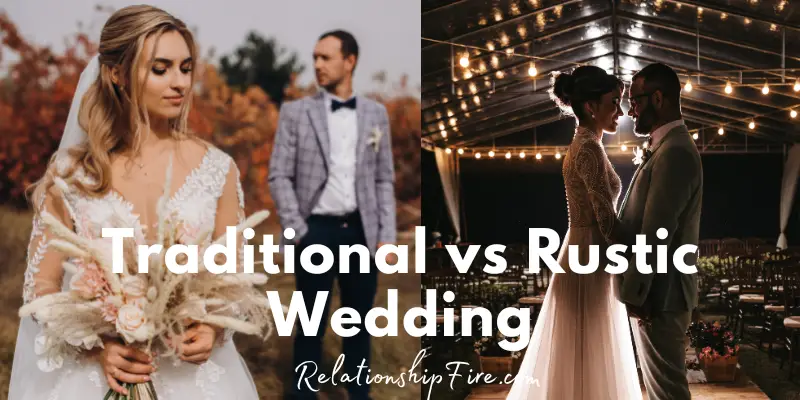When it comes to planning a wedding, there are numerous styles and themes to choose from.
Two popular options are traditional and rustic weddings. While both can create memorable and beautiful experiences, they have distinct characteristics that set them apart.
What Is a Traditional vs Rustic Wedding?
Traditional weddings are formal, held in religious venues, with ornate decor. Rustic weddings embrace a natural setting, organic decor, and a more relaxed ambiance, often in barns or gardens. Attire is formal in traditional weddings, while rustic weddings have a casual, bohemian vibe.
In this article, we’ll explore the key differences between traditional and rustic weddings, covering every aspect of the celebration.
Pre-Ceremony Differences

First, let’s talk about the differences between what happens in traditional vs rustic weddings before the ceremony.
You could call these the “pre-ceremony differences.”
Venue Selection
One of the major differences between traditional and rustic weddings lies in the choice of venue.
Traditional weddings often take place in religious institutions, such as churches or synagogues. These venues offer a formal and elegant atmosphere, reflecting the solemnity of the occasion.
On the other hand, rustic weddings typically occur in natural settings, such as barns, gardens, or vineyards.
These venues embrace a more relaxed and charming ambiance, surrounded by the beauty of nature.
Decorations
Decorations play a crucial role in setting the tone for the wedding.
In traditional weddings, decorations are often elaborate, featuring ornate floral arrangements, grand chandeliers, and luxurious fabrics.
The color palette tends to be classic and timeless, with white, ivory, and pastel shades dominating the scene.
Rustic weddings, on the other hand, favor a more organic and rustic aesthetic.
Decor elements often include burlap, lace, mason jars, and wildflowers.
The color scheme leans towards earthy tones, such as browns, greens, and soft yellows, enhancing the natural surroundings of the venue.
Invitations
Traditional wedding invitations are typically formal and sophisticated.
They are often printed on high-quality paper with elegant fonts and designs. The wording follows traditional etiquette, including the names of the hosts, requests for attendance, and details of the ceremony and reception.
Rustic wedding invitations embrace a more casual and rustic style.
They may feature kraft paper or other textured materials, with whimsical fonts and illustrations.
The wording tends to be more relaxed and personalized, reflecting the informal nature of the event.
During the Ceremony
Next, let’s cover the differences between rustic and traditional weddings during the actual ceremony.
Attire
Traditional wedding attire is typically formal and sophisticated.
The bride wears a traditional white gown, while the groom dons a tuxedo or a formal suit.
Bridesmaids and groomsmen are dressed in coordinated ensembles, following a specific color scheme.
Rustic weddings embrace a more relaxed and casual approach to attire.
Brides often opt for bohemian-style dresses or vintage-inspired gowns with lace and flowing fabrics.
Grooms may choose to wear a tailored suit or a more casual ensemble, such as suspenders and rolled-up sleeves.
Bridesmaids and groomsmen often wear mix-and-match outfits that reflect the laid-back and organic vibe of the event.
Ceremony Structure
Traditional wedding ceremonies often adhere to a formal structure, including religious rituals or customs.
There may be a processional, exchange of vows, rings, and a formal pronouncement of marriage.
The atmosphere is solemn and reverent, with religious or classical music playing in the background.
Rustic wedding ceremonies, on the other hand, are more flexible and personalized.
Couples have the freedom to design their own ceremony structure, incorporating elements that hold personal significance to them.
This may include writing their own vows, involving family members or friends in readings, or even incorporating cultural traditions.
The ambiance is often relaxed, intimate, and heartfelt.
Music
Music sets the mood during the ceremony and reflects the couple’s style.
In traditional weddings, the music choices often lean towards classical or religious hymns.
A live orchestra or a soloist may perform timeless pieces such as Pachelbel’s Canon or Wagner’s Bridal Chorus.
Rustic weddings offer a broader range of musical options.
Couples may choose acoustic guitarists, folk bands, or even opt for a playlist featuring their favorite songs.
The music selection tends to be more eclectic, reflecting the couple’s personal taste and the relaxed atmosphere of the event.
Photography and Videography
Photography and videography styles differ between traditional and rustic weddings.
Traditional weddings often emphasize formal posed shots and traditional video editing, aiming to capture classic and timeless images.
Rustic weddings, on the other hand, focus on capturing candid moments and incorporating the natural surroundings into the visual storytelling.
The photography style may have a more relaxed and organic feel, while videography may aim to create a more personalized and intimate wedding film.
Here is a video from a rustic wedding to show you what I mean:
Floral Arrangements
Floral arrangements contribute to the overall ambiance of the wedding.
Traditional weddings often feature large, elegant floral arrangements with classic flowers like roses and lilies.
The arrangements are carefully crafted and placed throughout the venue, enhancing the formal atmosphere.
In contrast, rustic weddings embrace a more natural and unstructured approach to floral decor.
Wildflower bouquets, greenery, and more organic arrangements are common, adding a touch of rustic charm and showcasing the beauty of nature.
Post-Ceremony Differences
Finally, we can’t leave out the differences after the wedding ceremony.
Reception
The reception is where the celebration truly comes to life.
In traditional weddings, the reception typically takes place in a formal venue, such as a hotel ballroom or banquet hall.
The decor is elegant and opulent, featuring elaborate centerpieces, fine china, and crystal glassware.
The evening is filled with formalities, including the first dance, toasts, and a sit-down dinner or multi-course meal.
Rustic wedding receptions, on the other hand, embrace a more casual and intimate atmosphere.
They often take place outdoors or in rustic venues such as barns or tents adorned with string lights.
The decor reflects the natural surroundings, with wooden accents, wildflower centerpieces, and vintage-inspired signage.
Food options may include buffet-style or family-style meals, and entertainment may involve live music or a DJ to get everyone on the dance floor.
Food and Drink
Traditional wedding receptions typically feature a formal sit-down dinner or a multi-course meal.
The menu is carefully planned, offering a selection of appetizers, entrees, and desserts.
The drinks menu often includes a variety of wines, spirits, and non-alcoholic beverages.
Rustic wedding receptions often embrace a more casual dining experience.
Couples may opt for food stations, buffet-style meals, or even food trucks. The menu may include comfort food, BBQ, or local cuisine.
As for drinks, couples may offer signature cocktails, craft beers, or even create a self-serve drink station with refreshing beverages.
Wedding Favors
Wedding favors are a token of appreciation for guests.
In traditional weddings, favors tend to be personalized, elegant items such as engraved keychains or small keepsake items.
They reflect the formal nature of the event and serve as a memento for guests.
In rustic weddings, favors often embrace a more nature-inspired theme.
Couples may opt for mini succulents, jars of homemade jam, or other rustic-inspired gifts that align with the relaxed and organic vibe of the celebration.
Wedding Cake
The wedding cake holds a special place in the reception.
Traditional wedding cakes are often multi-tiered, elegantly decorated with fondant or buttercream, and may feature classic flavors like vanilla or chocolate.
The designs are intricate and can incorporate elements such as sugar flowers or piped designs.
In contrast, rustic wedding cakes have a more natural and rustic appearance.
They may showcase textured buttercream, naked cake styles, or even incorporate elements like fresh flowers or fruits.
The flavors may be unique and reflect the couple’s personal taste, such as lavender, salted caramel, or other non-traditional flavors.
Guest Experience
The guest experience differs between traditional and rustic weddings.
Traditional weddings often have a larger guest count, as they are typically more formal affairs. Guests are expected to adhere to certain etiquette standards, such as dressing formally and following a structured timeline of events.
The focus is on witnessing the union of the couple and participating in the celebrations according to established traditions.
Rustic weddings, on the other hand, tend to be more intimate and personal.
The guest list is often smaller, allowing for a closer connection between the couple and their loved ones.
Guests are encouraged to relax, enjoy the natural surroundings, and participate in a more laid-back and interactive celebration.
It’s common to see lawn games, photo booths, or even bonfires as part of the rustic wedding experience.
Wedding Exit
The departure of the couple at the end of the reception can vary between traditional and rustic weddings.
In traditional weddings, there may be a grand exit with sparklers or a classic send-off with rice or flower petals.
These exits often symbolize good luck and create a magical moment for the couple’s departure.
In rustic weddings, the exit may take on a more rustic charm.
The couple may walk through a tunnel of bubbles, enjoy a romantic departure in a vintage car, or even have a sparkler-lit path that leads to their getaway vehicle.
Summary Chart of Traditional vs Rustic Wedding
Here is a summary chart of the differences between a traditional vs rustic wedding:
| Traditional Wedding | Rustic Wedding |
| Venue Selection: Religious institutions, formal venues | Venue Selection: Natural settings, barns, gardens, vineyards |
| Decorations: Elaborate, ornate, classic colors | Decorations: Organic, rustic, earthy tones |
| Invitations: Formal, elegant, traditional wording | Invitations: Casual, rustic, personalized wording |
| Attire: Formal, white gown, tuxedo/suit | Attire: Relaxed, bohemian, vintage-inspired |
| Ceremony Structure: Formal, religious rituals | Ceremony Structure: Personalized, flexible |
| Music: Classical, religious hymns | Music: Eclectic, acoustic, folk |
| Reception: Formal venue, elegant decor, sit-down dinner | Reception: Rustic venue, natural decor, buffet or food stations |
| Food and Drink: Multi-course meal, variety of drinks | Food and Drink: Casual dining, comfort food, signature cocktails |
| Photography and Videography: Formal, posed shots | Photography and Videography: Candid, natural, storytelling |
| Floral Arrangements: Large, classic flowers | Floral Arrangements: Natural, unstructured, wildflowers |
| Wedding Favors: Personalized, elegant items | Wedding Favors: Nature-inspired, rustic-themed |
| Wedding Cake: Multi-tiered, fondant or buttercream | Wedding Cake: Rustic appearance, textured buttercream or naked cake |
| Guest Experience: Larger guest count, formal etiquette | Guest Experience: Smaller guest list, relaxed and interactive atmosphere |
| Wedding Exit: Grand exit with sparklers, rice, or flower petals | Wedding Exit: Rustic-themed exit, bubbles, vintage car |
Final Thoughts: What Is a Traditional vs Rustic Wedding?
In summary, traditional and rustic weddings differ in various aspects, from pre-ceremony to post-ceremony.
Traditional weddings are characterized by formal venues, elaborate decorations, and structured ceremonies, while rustic weddings embrace natural settings, organic decor, and personalized ceremonies.
The choice between these two styles ultimately depends on the couple’s preferences and the atmosphere they wish to create on their special day.
Whether you opt for a traditional or rustic wedding, the most important thing is to create a celebration that reflects your love story and leaves lasting memories for you and your guests.
Related Posts:
